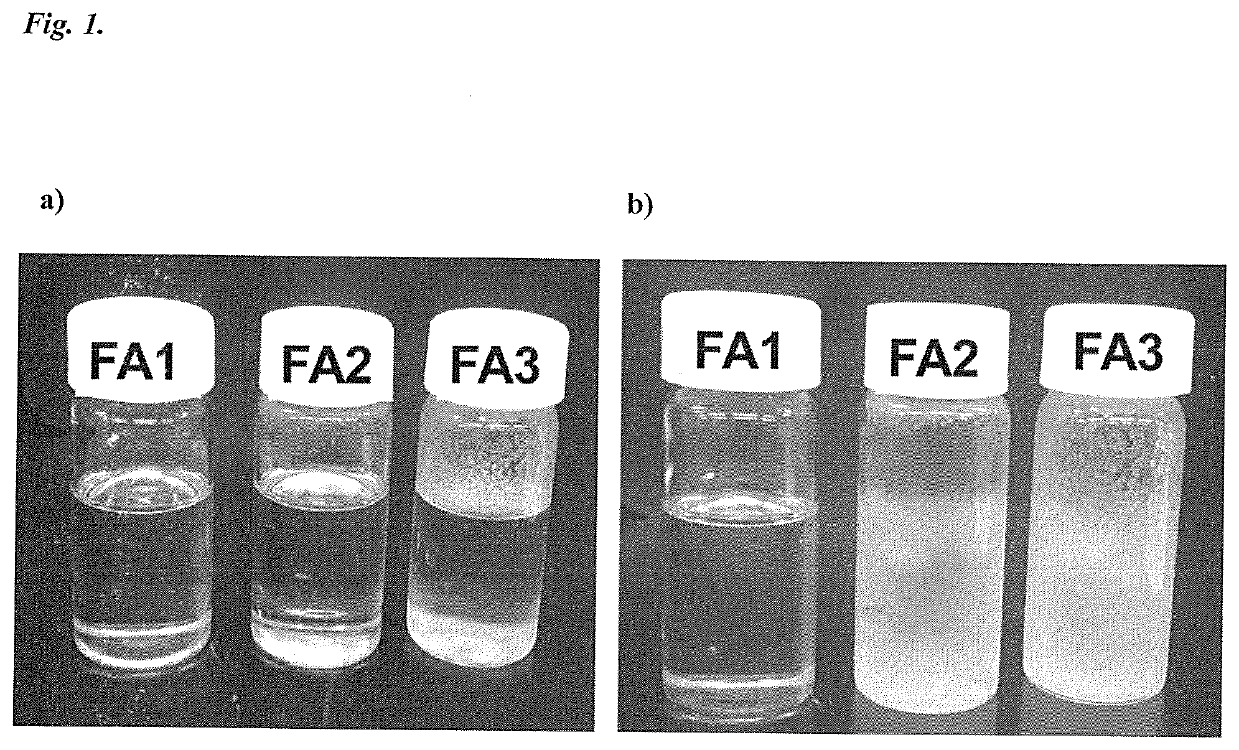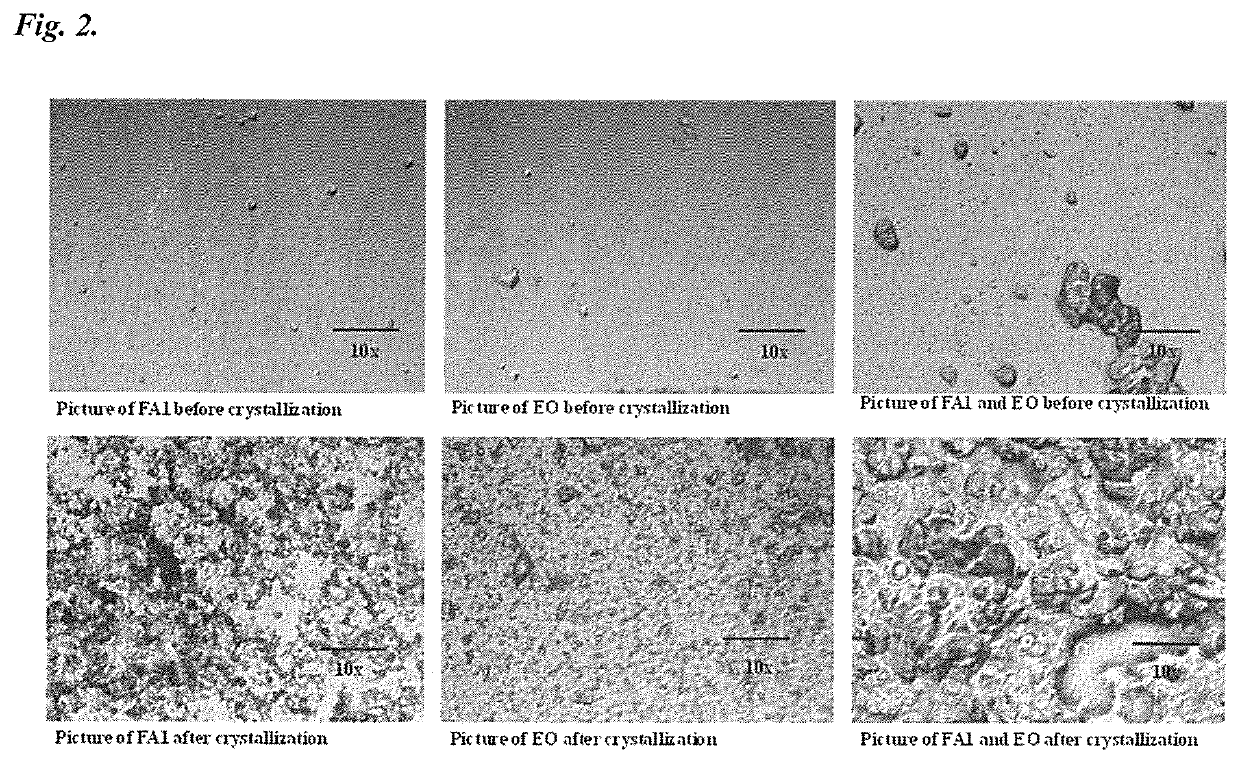Development of Lipid Matrix Granules with Incorporation of Polysaccharides for Effective Delivery of an Antimicrobial Essential Oil
a technology of antimicrobial essential oil and lipid matrix, which is applied in the direction of antibacterial agents, animal husbandry, aldehyde active ingredients, etc., can solve the problems of posing a significant public health threat, the most difficult cost-effective alternative to antibiotics, and the volatile nature of essential oils
- Summary
- Abstract
- Description
- Claims
- Application Information
AI Technical Summary
Benefits of technology
Problems solved by technology
Method used
Image
Examples
example 1
of a Fatty Acid Compatible with Thymol to Obtain Granules
[0090]As shown in FIG. 1a, there was no phase separation observed in the mixtures between thymol and all three fatty acids at room temperature (23° C.) for 0 min. As shown in FIG. 1b, after 10 h at room temperature (23° C.) the molten mixture of thymol and lauric acid was in liquid state without having phase separation. However, the molten mixture of thymol and palmitic acid started to solidify and formed a gel-like mixture and the same happened to the molten mixture of thymol and stearic acid. As shown in FIG. 2, lauric acid was in the form of droplets with round shapes when observed at room temperature (23° C.) before solidifying and the shape was still uniform after solidifying. Thymol was in round shaped particles before solidifying and the shape of the particles changed to an irregular shape after solidifying. The thymol and lauric acid mixture showed that before solidifying the particles were together which was also evid...
example 2
iagram of Lipid Matrix Granules with / without 2% Polysaccharides Observed with a Light Microscope
[0093]As shown in FIGS. 3 and 4, the diagram showing the outer surface of the picture revealed that there was a significant difference between the lipid matrix granules without polysaccharides when compared with lipid matrix granules with the addition of 2% polysaccharides. The surface of the lipid matrix granules without polysaccharides was coarse and had rough edges while the lipid matrix granules with the addition of 2% polysaccharide exhibited a smooth edge surface.
[0094]As will be appreciated by one of skill in the art, the smooth surface edge indicates the particles have a better sphericity and smaller specific surface area than the particles without added polysaccharide. As such, added polysaccharides such as alginate polysaccharide makes the particles more spherical and therefore more stable.
[0095]The composition of lipid matrix granules with polysaccharides incudes 66.22% corn st...
example 3
Release Profile of Thymol and Lauric Acid from Lipid Matrix Granules with / without 2% Polysaccharide Using Simulated Fluids
[0097]As shown in FIG. 5, the lipid matrix granules produced without 2% polysaccharide had quick release rates of thymol (79.9±11.8%) and lauric acid (80.8±5.9%) after incubated in the SSF for 2 min. When the lipid matrix granules were placed in the SGF for varying time intervals (30, 60, 80 and 120 min) respectively, the cumulative release (%) of thymol was 84.9±9.4, 86.6 4.7, 88.3±0 and 92.5±3.5, respectively. The cumulative release (%) of lauric acid was 69.9±9.4, 72.4±5.8, 74.1±5.8 and 75.8±5.9, respectively. Thymol and lauric acid were almost all released before getting to SIF and only few thymol (92.5±3.5; 93.3 4.6; 89.1±1.2; 93.3±9.4) % and lauric acid (87.4±12.9; 92.4±1.2; 93.3 2.4; 93.3±4.6) % were released in the SIF at 150, 180, 210 and 240 min respectively. However, as shown in FIG. 6 the lipid matrix granules with 2% polysaccharide exhibited a slow r...
PUM
| Property | Measurement | Unit |
|---|---|---|
| Fraction | aaaaa | aaaaa |
| Fraction | aaaaa | aaaaa |
| Fraction | aaaaa | aaaaa |
Abstract
Description
Claims
Application Information
 Login to View More
Login to View More - R&D
- Intellectual Property
- Life Sciences
- Materials
- Tech Scout
- Unparalleled Data Quality
- Higher Quality Content
- 60% Fewer Hallucinations
Browse by: Latest US Patents, China's latest patents, Technical Efficacy Thesaurus, Application Domain, Technology Topic, Popular Technical Reports.
© 2025 PatSnap. All rights reserved.Legal|Privacy policy|Modern Slavery Act Transparency Statement|Sitemap|About US| Contact US: help@patsnap.com



